Sarah L. Johnson's Blog, page 63
March 7, 2018
Googling Your Way Into the Past, an essay by E. Thomas Behr
Today I'm welcoming E. Thomas Behr, author of three historical novels, for a post about his research process, which should interest historical fiction writers as well as readers.
~
Googling Your Way Into the PastE. Thomas Behr
Author of Blood Brothers: Courage and Treachery on the Shores of Tripoli, The Most Bold and Daring Act of the Age, and the forthcoming Doppelgänger: An American Spy in Occupied France.
www.tombehrbooks.com
The challenge and pleasure of writing historical fiction is creating a vivid sense of another place and time for readers. That challenge, I believe, goes beyond simply describing an earlier world; it means to immerse one’s characters in that world so deeply that it comes alive in the characters’ speech, actions, thoughts, and feelings.
Thanks to Google, it’s not essential to have expert knowledge of the historical world that you want to bring to life in your fiction. The purpose of this article is to share some of the approaches I use in researching the background for my historical novels.
It starts with context, which for me means authoritative history. I can find the books I want on Google; in most cases they are available from Amazon, slightly used, for under $5.00. (An obvious disclaimer: always follow fair use principles and always acknowledge your sources.) Like other authors, I create complex biographies for my main characters that form the foundation for the character’s actions and thoughts in the novel itself. I do the same with physical locations − not only the details of what the settings look like, but also the politics, economy, social norms, and mostly the people – what the inhabitants feel. The result is that readers get to see, hear, smell, taste, touch, and sense what it’s like to live in that created world.
For example, my current novel nearing completion, Doppelgänger, is a World War II spy story. The following is a description of London during the Nazi Blitz drawn from on-line details.
The area around Bedford Square, a small residential close of perhaps 40 small, mostly two-story homes, had been hit with high explosive bombs. It looked as if a giant fist had smashed the entire block to rubble. Neighbors, rescue and first aid workers were clawing through the clutter to get to survivors. Stretcher bearers carried the wounded to the nearby ambulances through the chaos of shattered bricks, timbers, and broken glass. The dead bodies were stacked in open spaces along the street.
Exhausted as he was, as much from the horror he was experiencing as the exertion itself, Walter still forced himself to join a group pulling in almost furious anger at a jumble of still smoking wreckage. “There are children in here!” one of the rescuers urged. With the other rescuers, he feverishly helped clear the ruin of what had been a home: pieces of roof and shattered rafters, a long ragged strip of wall covered with ripped, blistered pink and blue chintz wallpaper, the splintered half of a carved table, beams with ragged plaster lath stuck to them, torn curtains, the broken shards of a lime-green vase, a drenched photo album.
Ten minutes later, they reached the bodies.
When a novel takes place in an historical setting like a city, I like to include period maps. These too, are easily found on Google. For Doppelgänger, I’m using copies of the 1939 Michelin Guide for France and a 1940 Map of London so that readers can walk the streets with the characters. And with the satellite view feature of Google maps, I’m often able to zoom in to street level and describe the actual buildings.
The same access to detail in Google exists with natural settings. In my most recent published novel, The Most Bold and Daring Act of the Age (2017), a Napoleonic War saga set in Algiers, I wanted to establish the setting of Kaf Ajnoun, the djinn-haunted Cave of the Devils in the forbidding mountain fortress of Idinen. Google gave me the detailed topographic features and dozens of photos of this eerie, nightmare landscape.
 Kaf Ajnoun
Kaf Ajnoun
Source of image: https://www.temehu.com/Cities_sites/kaf-ajnoun.htmGoogle also provides a means to create action scenes that otherwise would be hard to describe. For example, I wanted to give readers the experience of a sandstorm in the Sahara desert. I’ve never been to the Sahara, and have no interest at all in ever being caught in a sandstorm myself. But when I Googled “Sahara desert sandstorm” and clicked on “videos,” I discovered that some brave (foolhardy) soul had posted a YouTube cell phone video of a sandstorm overwhelming him in all its roaring, choking, purple-black fury. I just described what I saw in the video.
In my first novel, Blood Brothers: Courage and Treachery on the Shores of Tripoli (2011), I created a massive cavalry battle between opposing Bedouin armies, but I wanted the action to be real, and not a Hollywood version of a cavalry charge. Once again, Google to the rescue. I found an on-line copy of Napoleon’s manual of cavalry tactics, translated into English. I was able to give readers the feel of riding into the swirling dusty maelstrom of a battle that would have happened 200 years ago.
Finally, and most important, this kind of access to historical detail allows the characters themselves to experience what it means to live in the fictional world of the novel. Blood Brothers tells the story of America’s 1805 war with Tripoli and the incredible march of General William Eaton’s rag-tag army of mercenaries and a handful of US Marines across 500 miles of merciless Sahara desert. The details come from General Eaton’s letters, available on-line.
Each night they camped by large, spring-fed cisterns. One evening, after the men and animals had taken their fill and the water bags had been replenished, Kirkpatrick stood with Eaton, looking at the perfectly aligned stonework of the well’s sides disappearing below into the darkness.
“Who in the world do you think built these wells, General?”
“Marc Anthony’s Roman legionnaires,” answered Eaton. “These are the remains of Roman forts, built a day’s march apart.” He looked at the ruins around them, then ran his hand over the rough weathered stones on the well’s rim.
“This was the kingdom Anthony and Cleopatra meant to enjoy together.” Eaton looked up at the star-strewn sky above them. “Such great dreams. How does it go? ‘Let Rome in Tiber melt, and the wide arch of the ranged empire fall! Here is my space.’ And now the grave that clips them together lies only in our imaginations. So much for dreams. But this stonework has held up for almost two thousand years. I wonder if we Americans will leave a legacy like this behind us. People we can’t imagine, in a time far distant, will say with respect and wonder, ‘Ah. The Americans were here.’”
~
Googling Your Way Into the PastE. Thomas Behr
Author of Blood Brothers: Courage and Treachery on the Shores of Tripoli, The Most Bold and Daring Act of the Age, and the forthcoming Doppelgänger: An American Spy in Occupied France.
www.tombehrbooks.com
The challenge and pleasure of writing historical fiction is creating a vivid sense of another place and time for readers. That challenge, I believe, goes beyond simply describing an earlier world; it means to immerse one’s characters in that world so deeply that it comes alive in the characters’ speech, actions, thoughts, and feelings.
Thanks to Google, it’s not essential to have expert knowledge of the historical world that you want to bring to life in your fiction. The purpose of this article is to share some of the approaches I use in researching the background for my historical novels.
It starts with context, which for me means authoritative history. I can find the books I want on Google; in most cases they are available from Amazon, slightly used, for under $5.00. (An obvious disclaimer: always follow fair use principles and always acknowledge your sources.) Like other authors, I create complex biographies for my main characters that form the foundation for the character’s actions and thoughts in the novel itself. I do the same with physical locations − not only the details of what the settings look like, but also the politics, economy, social norms, and mostly the people – what the inhabitants feel. The result is that readers get to see, hear, smell, taste, touch, and sense what it’s like to live in that created world.
For example, my current novel nearing completion, Doppelgänger, is a World War II spy story. The following is a description of London during the Nazi Blitz drawn from on-line details.
The area around Bedford Square, a small residential close of perhaps 40 small, mostly two-story homes, had been hit with high explosive bombs. It looked as if a giant fist had smashed the entire block to rubble. Neighbors, rescue and first aid workers were clawing through the clutter to get to survivors. Stretcher bearers carried the wounded to the nearby ambulances through the chaos of shattered bricks, timbers, and broken glass. The dead bodies were stacked in open spaces along the street.
Exhausted as he was, as much from the horror he was experiencing as the exertion itself, Walter still forced himself to join a group pulling in almost furious anger at a jumble of still smoking wreckage. “There are children in here!” one of the rescuers urged. With the other rescuers, he feverishly helped clear the ruin of what had been a home: pieces of roof and shattered rafters, a long ragged strip of wall covered with ripped, blistered pink and blue chintz wallpaper, the splintered half of a carved table, beams with ragged plaster lath stuck to them, torn curtains, the broken shards of a lime-green vase, a drenched photo album.
Ten minutes later, they reached the bodies.
When a novel takes place in an historical setting like a city, I like to include period maps. These too, are easily found on Google. For Doppelgänger, I’m using copies of the 1939 Michelin Guide for France and a 1940 Map of London so that readers can walk the streets with the characters. And with the satellite view feature of Google maps, I’m often able to zoom in to street level and describe the actual buildings.
The same access to detail in Google exists with natural settings. In my most recent published novel, The Most Bold and Daring Act of the Age (2017), a Napoleonic War saga set in Algiers, I wanted to establish the setting of Kaf Ajnoun, the djinn-haunted Cave of the Devils in the forbidding mountain fortress of Idinen. Google gave me the detailed topographic features and dozens of photos of this eerie, nightmare landscape.
 Kaf Ajnoun
Kaf AjnounSource of image: https://www.temehu.com/Cities_sites/kaf-ajnoun.htmGoogle also provides a means to create action scenes that otherwise would be hard to describe. For example, I wanted to give readers the experience of a sandstorm in the Sahara desert. I’ve never been to the Sahara, and have no interest at all in ever being caught in a sandstorm myself. But when I Googled “Sahara desert sandstorm” and clicked on “videos,” I discovered that some brave (foolhardy) soul had posted a YouTube cell phone video of a sandstorm overwhelming him in all its roaring, choking, purple-black fury. I just described what I saw in the video.
In my first novel, Blood Brothers: Courage and Treachery on the Shores of Tripoli (2011), I created a massive cavalry battle between opposing Bedouin armies, but I wanted the action to be real, and not a Hollywood version of a cavalry charge. Once again, Google to the rescue. I found an on-line copy of Napoleon’s manual of cavalry tactics, translated into English. I was able to give readers the feel of riding into the swirling dusty maelstrom of a battle that would have happened 200 years ago.
Finally, and most important, this kind of access to historical detail allows the characters themselves to experience what it means to live in the fictional world of the novel. Blood Brothers tells the story of America’s 1805 war with Tripoli and the incredible march of General William Eaton’s rag-tag army of mercenaries and a handful of US Marines across 500 miles of merciless Sahara desert. The details come from General Eaton’s letters, available on-line.
Each night they camped by large, spring-fed cisterns. One evening, after the men and animals had taken their fill and the water bags had been replenished, Kirkpatrick stood with Eaton, looking at the perfectly aligned stonework of the well’s sides disappearing below into the darkness.
“Who in the world do you think built these wells, General?”
“Marc Anthony’s Roman legionnaires,” answered Eaton. “These are the remains of Roman forts, built a day’s march apart.” He looked at the ruins around them, then ran his hand over the rough weathered stones on the well’s rim.
“This was the kingdom Anthony and Cleopatra meant to enjoy together.” Eaton looked up at the star-strewn sky above them. “Such great dreams. How does it go? ‘Let Rome in Tiber melt, and the wide arch of the ranged empire fall! Here is my space.’ And now the grave that clips them together lies only in our imaginations. So much for dreams. But this stonework has held up for almost two thousand years. I wonder if we Americans will leave a legacy like this behind us. People we can’t imagine, in a time far distant, will say with respect and wonder, ‘Ah. The Americans were here.’”
Published on March 07, 2018 05:00
March 5, 2018
Madeline Miller's Circe, historical fantasy about a mythological sorceress and feminine power
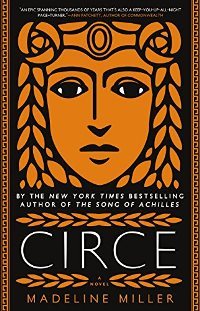 In her stirring follow-up to the Orange Prize–winning The Song of Achilles (2011), Miller beautifully voices the experiences of the legendary sorceress Circe.
In her stirring follow-up to the Orange Prize–winning The Song of Achilles (2011), Miller beautifully voices the experiences of the legendary sorceress Circe.The misfit daughter of the Greek sun god, Helios, her powers are weak and her speech too much like a mortal’s. But her unexpected talents in witchcraft prove threatening to the Titans’ realm, leading to her banishment to the remote island of Aiaia. There she resides, carefully perfecting her herb lore, until her solitude is disrupted by visitors both human and divine.
With poetic eloquence (“the days moved slowly, dropping like petals from a blown rose”) and fine dramatic pacing, Miller smoothly knits together the classic stories of the Minotaur, the monster Scylla, the witch Medea (Circe’s niece), events from Homer’s Odyssey, and more, all reimagined from a strong-minded woman’s viewpoint.
Circe’s potential rival, Odysseus’ wife, Penelope, is another memorable character, and the novel speaks to women’s agency, war’s traumatic aftermath, and how strength emerges from emotional growth. This immersive blend of literary fiction and mythological fantasy demonstrates that the Greek myths are still very relevant today.
My review of Circe first appeared in Booklist's March 1 issue, and the novel will be published by Little, Brown just over a month from now. on April 10th. Readers may want to note that it falls closer to the "fantasy" end of the historical fantasy spectrum (it's being classified by the publisher as historical fiction, though a good part of the novel takes place in the realms of Greek mythology).
Published on March 05, 2018 05:00
March 2, 2018
Writing Historical Fiction: Reflections on writing about a foreign history and culture, an essay by Chrystyna Lucyk-Berger
I'm pleased to welcome Chrystyna Lucyk-Berger to the blog today. In addition to her newly published historical novels, described below, she's the author of "Souvenirs from Kiev," a short story that won 2nd place in the Historical Novel Society's Short Story Award 2014, and which was published in
Distant Echoes
, a 2017 anthology with 19 stories receiving honors in recent HNS competitions.
~
Writing Historical Fiction:Reflections on writing about a foreign history and culture Chrystyna Lucyk-Berger
I am an American, living in Austria, a regular visitor to Italy, and my latest novels take place in the former Austrian Tyrol, which now belongs to Italy.
Confused? Stick with me. I’ve got a story to tell.
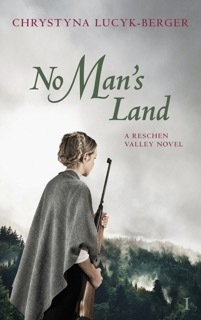 In 2005, I started writing a story that took place within the systematic oppression of the Austrian Tyroleans. Their province was severed in two and annexed by Italy in 1920. For reasons that require an entirely different telling, I got interested in this history. The more I researched, the deeper the story got under my skin and, the next thing I knew, I was working on the Reschen Valley series.
In 2005, I started writing a story that took place within the systematic oppression of the Austrian Tyroleans. Their province was severed in two and annexed by Italy in 1920. For reasons that require an entirely different telling, I got interested in this history. The more I researched, the deeper the story got under my skin and, the next thing I knew, I was working on the Reschen Valley series.
I had moved to Austria three years earlier while working on an entirely different historical novel based in Ukraine. Because I have Ukrainian roots and speak the language, writing that seemed easier than the undertaking I began in 2005. For that Ukrainian novel, I had the background and language necessary to confidently depict the culture. When I began tackling the Austrian-Italian conflict, I was running up against brick walls not only in the limited research available in English, but also in understanding the Tyrolean and Italian cultures and their intricacies. I had the daunting task of portraying a foreign world as accurately as possible, a world that was also foreign to me.
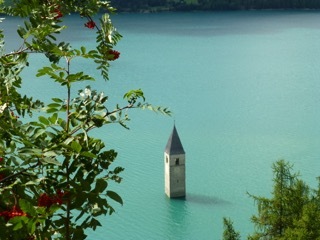 Not only were the differences in the Italian and Austrian cultures important, finding the parallels between my characters were key for development. I avoided taking sides in this conflict. So, more importantly than getting the specific details and differences down, I was also looking for common ground available to my characters. Further, when I studied their specific language barriers and cultural barriers, I found a lot of dry hay to play with, and I started lighting matches for the purposes of intensifying the tension as well as for creating complexities and layers, even humor.
Not only were the differences in the Italian and Austrian cultures important, finding the parallels between my characters were key for development. I avoided taking sides in this conflict. So, more importantly than getting the specific details and differences down, I was also looking for common ground available to my characters. Further, when I studied their specific language barriers and cultural barriers, I found a lot of dry hay to play with, and I started lighting matches for the purposes of intensifying the tension as well as for creating complexities and layers, even humor.
I also had to make decisions about how I present this foreign world to an English-speaking audience. The techniques of introducing foreign words for the purpose of authenticity, for example, must be done with careful consideration. Secondly, I had to assure that certain aspects of the foreign world were not so foreign that they would disorient or distract. This selection process created a nagging worry about not being able to do justice to the Tyroleans or the Italians.
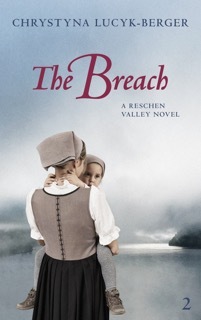 For starters, I would like nothing more than to have these novels translated into German and Italian. I believe both of these cultures are still trying to come to terms with their history. My fear is that, with a translation, the culture, the language and even the world I’ve created for this series will come out filtered. And with a heavy dilution, you have the risk that those who live within these cultures – these languages! – will not be able to recognise the world I have so painstakingly created for a foreign audience.
For starters, I would like nothing more than to have these novels translated into German and Italian. I believe both of these cultures are still trying to come to terms with their history. My fear is that, with a translation, the culture, the language and even the world I’ve created for this series will come out filtered. And with a heavy dilution, you have the risk that those who live within these cultures – these languages! – will not be able to recognise the world I have so painstakingly created for a foreign audience.
Which begs the question: What right do I have to write about this conflict in the first place? Will my novels fail in those countries?
Someone once wisely said that there is no such thing as bad publicity. This is what I imagine is going to happen when the book gets distributed in German- and Italian-speaking countries: Either the reader is going to say, “This is such hooey! An American wrote it,” or they are going to say, “This is so great! An American wrote it!” In the end, I remind myself that my job is to write a story about characters people will recognise and empathise with. Emotion is a novelist’s common denominator no matter where their story takes place. And because I most definitely have a story to tell, that must take priority in the craft.
~
 Chrystyna Lucyk-Berger grew up in Minneapolis, Minnesota and now lives in the mountains of Austria with her hilarious dog, royally possessive cat, and phenomenal husband. Her series, Reschen Valley, is releasing throughout 2018 and 2019. No Man’s Land and The Breach, the first two in the series, are available now and on March 15th, respectively. You can join her newsletter for special deals, book launches, releases and promotions at: https://www.subscribepage.com/ReschenValley
Chrystyna Lucyk-Berger grew up in Minneapolis, Minnesota and now lives in the mountains of Austria with her hilarious dog, royally possessive cat, and phenomenal husband. Her series, Reschen Valley, is releasing throughout 2018 and 2019. No Man’s Land and The Breach, the first two in the series, are available now and on March 15th, respectively. You can join her newsletter for special deals, book launches, releases and promotions at: https://www.subscribepage.com/ReschenValley
Her novels are available in e-book and paperback formats (and Kindle Unlimited) on Amazon under: amazon.com/author/chrystynalucykberger.
~
Writing Historical Fiction:Reflections on writing about a foreign history and culture Chrystyna Lucyk-Berger
I am an American, living in Austria, a regular visitor to Italy, and my latest novels take place in the former Austrian Tyrol, which now belongs to Italy.
Confused? Stick with me. I’ve got a story to tell.
 In 2005, I started writing a story that took place within the systematic oppression of the Austrian Tyroleans. Their province was severed in two and annexed by Italy in 1920. For reasons that require an entirely different telling, I got interested in this history. The more I researched, the deeper the story got under my skin and, the next thing I knew, I was working on the Reschen Valley series.
In 2005, I started writing a story that took place within the systematic oppression of the Austrian Tyroleans. Their province was severed in two and annexed by Italy in 1920. For reasons that require an entirely different telling, I got interested in this history. The more I researched, the deeper the story got under my skin and, the next thing I knew, I was working on the Reschen Valley series. I had moved to Austria three years earlier while working on an entirely different historical novel based in Ukraine. Because I have Ukrainian roots and speak the language, writing that seemed easier than the undertaking I began in 2005. For that Ukrainian novel, I had the background and language necessary to confidently depict the culture. When I began tackling the Austrian-Italian conflict, I was running up against brick walls not only in the limited research available in English, but also in understanding the Tyrolean and Italian cultures and their intricacies. I had the daunting task of portraying a foreign world as accurately as possible, a world that was also foreign to me.
 Not only were the differences in the Italian and Austrian cultures important, finding the parallels between my characters were key for development. I avoided taking sides in this conflict. So, more importantly than getting the specific details and differences down, I was also looking for common ground available to my characters. Further, when I studied their specific language barriers and cultural barriers, I found a lot of dry hay to play with, and I started lighting matches for the purposes of intensifying the tension as well as for creating complexities and layers, even humor.
Not only were the differences in the Italian and Austrian cultures important, finding the parallels between my characters were key for development. I avoided taking sides in this conflict. So, more importantly than getting the specific details and differences down, I was also looking for common ground available to my characters. Further, when I studied their specific language barriers and cultural barriers, I found a lot of dry hay to play with, and I started lighting matches for the purposes of intensifying the tension as well as for creating complexities and layers, even humor. I also had to make decisions about how I present this foreign world to an English-speaking audience. The techniques of introducing foreign words for the purpose of authenticity, for example, must be done with careful consideration. Secondly, I had to assure that certain aspects of the foreign world were not so foreign that they would disorient or distract. This selection process created a nagging worry about not being able to do justice to the Tyroleans or the Italians.
 For starters, I would like nothing more than to have these novels translated into German and Italian. I believe both of these cultures are still trying to come to terms with their history. My fear is that, with a translation, the culture, the language and even the world I’ve created for this series will come out filtered. And with a heavy dilution, you have the risk that those who live within these cultures – these languages! – will not be able to recognise the world I have so painstakingly created for a foreign audience.
For starters, I would like nothing more than to have these novels translated into German and Italian. I believe both of these cultures are still trying to come to terms with their history. My fear is that, with a translation, the culture, the language and even the world I’ve created for this series will come out filtered. And with a heavy dilution, you have the risk that those who live within these cultures – these languages! – will not be able to recognise the world I have so painstakingly created for a foreign audience. Which begs the question: What right do I have to write about this conflict in the first place? Will my novels fail in those countries?
Someone once wisely said that there is no such thing as bad publicity. This is what I imagine is going to happen when the book gets distributed in German- and Italian-speaking countries: Either the reader is going to say, “This is such hooey! An American wrote it,” or they are going to say, “This is so great! An American wrote it!” In the end, I remind myself that my job is to write a story about characters people will recognise and empathise with. Emotion is a novelist’s common denominator no matter where their story takes place. And because I most definitely have a story to tell, that must take priority in the craft.
~
 Chrystyna Lucyk-Berger grew up in Minneapolis, Minnesota and now lives in the mountains of Austria with her hilarious dog, royally possessive cat, and phenomenal husband. Her series, Reschen Valley, is releasing throughout 2018 and 2019. No Man’s Land and The Breach, the first two in the series, are available now and on March 15th, respectively. You can join her newsletter for special deals, book launches, releases and promotions at: https://www.subscribepage.com/ReschenValley
Chrystyna Lucyk-Berger grew up in Minneapolis, Minnesota and now lives in the mountains of Austria with her hilarious dog, royally possessive cat, and phenomenal husband. Her series, Reschen Valley, is releasing throughout 2018 and 2019. No Man’s Land and The Breach, the first two in the series, are available now and on March 15th, respectively. You can join her newsletter for special deals, book launches, releases and promotions at: https://www.subscribepage.com/ReschenValleyHer novels are available in e-book and paperback formats (and Kindle Unlimited) on Amazon under: amazon.com/author/chrystynalucykberger.
Published on March 02, 2018 05:00
February 28, 2018
Winner and finalists for the 2017 Langum Prize in American Historical Fiction
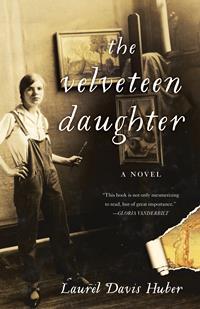 The Langum Charitable Trust has just announced the winner and finalists for the Langum Prize in American Historical Fiction for 2017.
The Langum Charitable Trust has just announced the winner and finalists for the Langum Prize in American Historical Fiction for 2017.Laurel Davis Huber's The Velveteen Daughter (She Writes, 2017) has taken top honors.
From the press release: "Laurel Davis Huber’s The Velveteen Daughter composes the documented but unassembled lives of author and artist, as well as mother and daughter Margery Williams Bianco and Pamela Bianco. While Margery Williams Bianco’s Velveteen Rabbit is still cherished by contemporary generations, her daughter Pamela Bianco was arguably more famous in her lifetime ... While the novel includes vivid scenes of bohemian life both in Wales and Italy, as well as Greenwich Village and Harlem, The Velveteen Daughter is ultimately a novel about the intimate dynamics of familial and romantic love with its myriad expectations and disappointments."
For some background, read the author's guest post for this site, On Researching The Velveteen Daughter, and my review of the book from last July. It's an excellent selection.
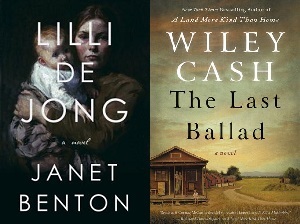
The two finalists for the prize are Wiley Cash's The Last Ballad (Morrow) and Janet Benton's Lilli de Jong (Doubleday).
In addition, in the prize announcement, David J. Langum, Sr., Director of the Langum Charitable Trust, discusses three notable works of American historical fiction from 2017: Eleanor Henderson's The Twelve Mile Straight, Jennifer Egan's Manhattan Beach, and Jane Kirkpatrick's All She Left Behind.
For more information, see the Langum Charitable Trust website.
Published on February 28, 2018 05:00
February 22, 2018
The Silver Well by Kate Forsyth and Kim Wilkins, linked stories about a Dorset village's ancient, mystical history
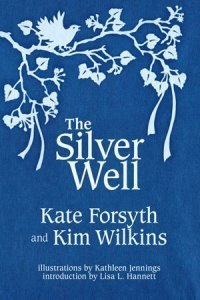 Many of the world’s mystical places have remained so for centuries, even millennia. In this absorbing collection, the authors present seven stories, all linked through their setting of Cerne Abbas, a village in Dorset, which is home to an ancient wishing well and a giant (and well-endowed) hill-figure sculpted into the chalk countryside. The folk beliefs of the region play a strong role in each story, each of which is extraordinarily attuned to its era while evoking the timelessness of human emotions: protectiveness, jealousy, hope, fear, and love.
Many of the world’s mystical places have remained so for centuries, even millennia. In this absorbing collection, the authors present seven stories, all linked through their setting of Cerne Abbas, a village in Dorset, which is home to an ancient wishing well and a giant (and well-endowed) hill-figure sculpted into the chalk countryside. The folk beliefs of the region play a strong role in each story, each of which is extraordinarily attuned to its era while evoking the timelessness of human emotions: protectiveness, jealousy, hope, fear, and love. The book opens in the present day, with Rosie Brightwell, an Australian woman, visiting her grandparents’ English birthplace after a messy breakup. The subsequent tales progressively lead further back in time, detailing the lives of earlier Brightwells and their lovers, neighbors, and adversaries, and finally conclude with the remainder of Rosie’s story. It’s hard to pick a favorite!
“My Sister’s Ghost” is a suspenseful Victorian ghost story suffused with grief and desperation, and with a delightful child narrator. In “The True Confession of Obedience-to-God Ashe,” full of devilish twists, a Puritan parson’s spiteful daughter uses the well’s power to achieve her desire. Set in 999 AD, a time of panic and prophecy, “The End of Everything” tells of the gentle love between an unlikely couple.
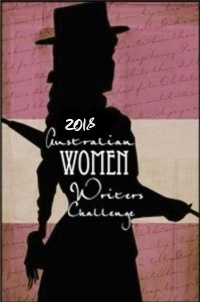 “The Cunning Woman’s Daughter” is a well-crafted Tudor mystery told against the backdrop of the Dissolution of the Monasteries. Perhaps the most moving is “The Blessing,” which sees a young woman reacting to the devastation of World War II. And “The Giant” shows the villagers in 44 AD, preparing for the expected Roman incursion in different ways.
“The Cunning Woman’s Daughter” is a well-crafted Tudor mystery told against the backdrop of the Dissolution of the Monasteries. Perhaps the most moving is “The Blessing,” which sees a young woman reacting to the devastation of World War II. And “The Giant” shows the villagers in 44 AD, preparing for the expected Roman incursion in different ways.The stories are tinged with supernatural happenings. This is a satisfying, multi-dimensional read for anyone who likes pondering history’s deep and intricate layers.
The Silver Well was published in 2017 by Australia's Ticonderoga Press. This review, published also in February's Historical Novels Review, was based on a personal purchase. The book is available in paperback ($21.99 US, $30 in Australia) and ebook ($5.99 US).
This is also my first entry for the 2018 Australian Women Writers Challenge. Hopefully I'll do better this year than last. I'll try the Stella level, reading four and reviewing three.
Published on February 22, 2018 17:00
February 19, 2018
Book review: The Secret Life of Mrs. London, by Rebecca Rosenberg
 Historical fiction readers know it’s no picnic being a famous author’s wife. These admirable women have endured their husbands’ egos, partying, and infidelity, supported them through illness, and sacrificed their own writing ambitions in their favor.
Historical fiction readers know it’s no picnic being a famous author’s wife. These admirable women have endured their husbands’ egos, partying, and infidelity, supported them through illness, and sacrificed their own writing ambitions in their favor.All of these were true of Jack London’s second wife, Charmian Kittredge London, yet she may be the least known of these heroines today. As such, biographical articles revealing the true history of her life and the couple’s partnership come as a surprise. A well-educated heiress and travel writer who personified the early 20th-century “New Woman,” she was hardly a shrinking violet. And still her importance in his life is overlooked because, as London’s muse, spouse, and editor, she held roles that were kept in his shadow.
Rosenberg’s strong debut, the first novel to focus on this deserving subject, presents Charmian in her element. An unapologetically bold and sexually liberated woman, Charmian loves her adventurous husband but chafes at settling for less than she deserves.
It opens at their extensive ranch home among the redwoods in Sonoma Valley, California, in 1915. President Wilson is weighing his options for entering WWI, and against this politically troubled historical backdrop, Charmian is doing her best to support her husband’s career: “Jack’s golden rule: write a thousand words a day. And my job is to keep him to it.” And if she can work in a “grand lolly” afterwards that will satisfy them both, and hopefully give her a child, so much the better.
However, their sex life is stalling, their new home’s construction is a money pit, and he discourages her writing efforts. Despite being a dedicated Socialist, he also gets upset when she points out the contradiction between his longtime beliefs and his desires to expand their land.
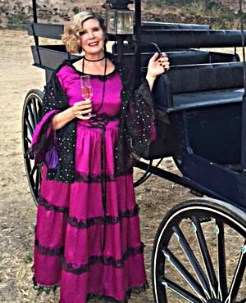 author Rebecca RosenbergWhile Jack encourages her flirtations, she quickly gets in over her head after she participates in an on-stage magic show by the charismatic Great Houdini – and forms an unlikely friendship with his wife, Bess, whose quirkiness and childlike looks belie a deeper wisdom. Depictions of Charmian’s complicated relationships with both Houdinis are a highlight of the book. The "Magic Man" himself has an electrifying presence, one to which Charmian isn’t immune.
author Rebecca RosenbergWhile Jack encourages her flirtations, she quickly gets in over her head after she participates in an on-stage magic show by the charismatic Great Houdini – and forms an unlikely friendship with his wife, Bess, whose quirkiness and childlike looks belie a deeper wisdom. Depictions of Charmian’s complicated relationships with both Houdinis are a highlight of the book. The "Magic Man" himself has an electrifying presence, one to which Charmian isn’t immune. Her passionate quest for love and purpose unfolds against the stirrings of war, Houdini’s death-defying escapes, and the surprising intersection between them (Houdini’s unique contributions to the war effort are fascinating, yet little-known).
Through her dynamic narrative, Charmian is presented as a flawed and fascinating character whose eventful life holds our attention. Her phrasings are occasionally clichéd (“…shatters my heart into a million tiny pieces”), but she comes across as a force of nature with an original outlook on her world.
From the sun-drenched waters of Hawaii to the skyscrapers of the nation’s capital, the novel explores the risks and secret joys of following one’s heart.
The Secret Life of Mrs. London was published on January 30 by Lake Union/Amazon (348pp). View the other stops on the blog tour.
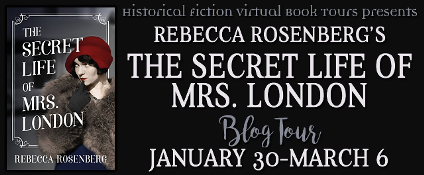
Published on February 19, 2018 03:30
February 15, 2018
White Chrysanthemum by Mary Lynn Bracht, an unflinching saga of family and the Korean "comfort women"
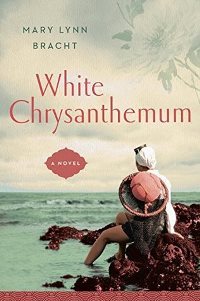 “Comfort women” is a euphemism for the girls and women forced to serve as prostitutes by Imperial Japanese forces during WWII—perhaps 200,000 in all. Official recognition of their plight was long in coming, and even today, statues commemorating them are controversial; the issue remains a sticking point in Japanese-South Korean relations. Bracht’s debut novel, focusing on two courageous Korean sisters torn apart by the war, unflinchingly explores this subject and its long aftermath.
“Comfort women” is a euphemism for the girls and women forced to serve as prostitutes by Imperial Japanese forces during WWII—perhaps 200,000 in all. Official recognition of their plight was long in coming, and even today, statues commemorating them are controversial; the issue remains a sticking point in Japanese-South Korean relations. Bracht’s debut novel, focusing on two courageous Korean sisters torn apart by the war, unflinchingly explores this subject and its long aftermath. Her prose is fast-paced and lyrical—not an easy combination to achieve—in her alternating portraits of Emi, an elderly Korean widow in 2011, and her older sister Hana, who had sacrificed herself to protect Emi when Japanese soldiers came walking along the beachfront near their home in 1943. For generations, their family’s women have been divers, haenyeo, on Korea’s Jeju Island, feeding their children with the fruits of the sea. One can sense their strength as they hold their breath for long minutes underwater, and this same strength helps them endure what follows. Transported to Manchuria by train, Hana finds herself trapped in a brothel where each woman is assigned a “flower” name and raped numerous times a day.
Emi’s story, as she boards a plane to visit her children in Seoul, initially seems undramatic in comparison, but subtle points revealing her truth emerge: occasional nightmares, her hesitation about flying (why?), hints at an unhappy marriage. Driving the plot forward are questions about Hana’s fate, and whether the sisters’ lives will ever intertwine again.
This emotion-filled literary saga carries readers into the world of Koreans—and Korean women in particular—as they suffer first under Japanese occupation and then their own country’s civil war. It’s difficult to read at times, but compelling all the same, and the author allows a sense of hope to filter through.
White Chrysanthemum was published by Putnam this month in the US, and by Chatto & Windus in the UK. I wrote this review for February's Historical Novels Review.
This thought-provoking novel couldn't be more relevant. With the 2018 Winter Olympics currently underway in PyeongChang, South Korea, the issue of the "comfort women" is very much in today's headlines. See this article from Voice of America last Friday regarding the Japanese and South Korean leaders' discussions about their countries' controversial 2015 agreement relating to these women.
Published on February 15, 2018 05:00
February 12, 2018
Historical fiction award winners from ALA Midwinter 2018
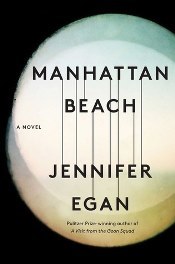 Last night in Denver, many literary awards were announced at the American Library Association's Midwinter conference. Although I didn't attend this year, I was paying attention on social media while tuning in to Olympics figure skating on the TV behind me.
Last night in Denver, many literary awards were announced at the American Library Association's Midwinter conference. Although I didn't attend this year, I was paying attention on social media while tuning in to Olympics figure skating on the TV behind me.Here are the historical novels that were honored at the Reference and User Services Association's Book and Media Awards ceremony. Links go to the ALA press releases.
2018 Andrew Carnegie Medal for Fiction: Jennifer Egan's Manhattan Beach, a fast-paced historical novel set in WWII New York.
2018 Reading List, which selects the best in genre fiction for adult readers (descriptions are mine):
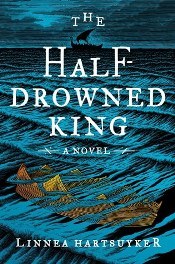 In the Historical Fiction category, the winner was Linnea Hartsuyker's The Half-Drowned King, a stellar epic of 9th-century Norway. I wrote a starred review of it for Booklist last year and am excited to see it win. The next book in the trilogy, The Sea Queen, will be out this summer.
In the Historical Fiction category, the winner was Linnea Hartsuyker's The Half-Drowned King, a stellar epic of 9th-century Norway. I wrote a starred review of it for Booklist last year and am excited to see it win. The next book in the trilogy, The Sea Queen, will be out this summer.On the Historical Fiction short list:
The Confessions of Young Nero, by Margaret George, in which the oft-maligned Roman emperor offers a different view of his early life [see my review];
Pachinko by Min Jin Lee, a sweeping saga about Koreans in 20th-century Japan [see my review];
Golden Hill: A Novel of Old New York by Francis Spufford, an adventurous journey through 18th-century New York;
Miss Kopp’s Midnight Confessions: A Kopp Sisters Novel by Amy Stewart, continuing the story of a female deputy sheriff during the WWI years.
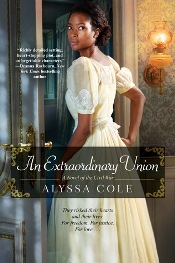 And in the Romance category, the winner was Alyssa Cole's An Extraordinary Union, a novel of espionage and forbidden love during the Civil War, with a free black woman as heroine. This is one of many accolades the novel has received.
And in the Romance category, the winner was Alyssa Cole's An Extraordinary Union, a novel of espionage and forbidden love during the Civil War, with a free black woman as heroine. This is one of many accolades the novel has received.On the 2018 ALA Notable Books list are several historical novels:
Days Without End by Sebastian Barry (also the most recent Walter Scott Prize winner)
The Last Ballad by Wiley Cash
Pachinko by Min Jin Lee
Lincoln in the Bardo by George Saunders (the latest Booker Prize winner)
Novels on the Notable Books list are literary fiction, while the Reading List covers genre fiction. Since novels in the historical fiction genre can also be literary, there is some overlap.
Congrats to the winners and shortlisted authors!
Published on February 12, 2018 05:00
February 9, 2018
The Countess of Prague by Stephen Weeks, a wild and witty mystery of early 20th-century Europe
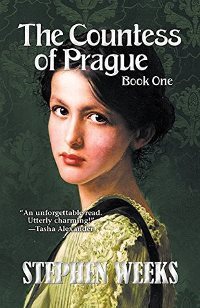 This first entry in a projected ten-volume series welcomes a sassy aristocratic heroine who steps outside her exalted circles to solve crimes and has a great time doing so. It’s 1904 in Prague, and Countess Beatrice “Trixie” von Falklenburg gets drawn into an irresistible mystery when her great-uncle Berty is informed that a body caught in the Vltava River is that of his old army batman, Alois. However, the old soldiers’ home still claims Alois as a current resident.
This first entry in a projected ten-volume series welcomes a sassy aristocratic heroine who steps outside her exalted circles to solve crimes and has a great time doing so. It’s 1904 in Prague, and Countess Beatrice “Trixie” von Falklenburg gets drawn into an irresistible mystery when her great-uncle Berty is informed that a body caught in the Vltava River is that of his old army batman, Alois. However, the old soldiers’ home still claims Alois as a current resident.Alois had been Uncle Berty’s representative in a Tontine, an investment lottery in which the member with the last surviving nominee reaps all the benefits, so his death would be bad news for Berty. Curiously, someone besides Berty clearly has a motive for wanting Alois to appear alive, but who?
The intrepid Trixie dives eagerly into the investigation, although for her family’s sake, she can’t let on that the “Alois” in the home is probably an impostor. Her madcap adventure takes her from an unusual fancy-dress ball to the fashionable spa town of Marienbad to a train bound for London. She chops off her hair, dons a poor urchin’s garb, and gets accused of murder. Most shockingly, she says “thank you” to a servant for the first time ever.
The Countess is absolutely delightful. She charms everyone from her mini-garrison of urchin helpers to King Edward VII himself, and her excitement at breaking free of her snobby social confines is infectious. Her French ladies’ maid, Sabine, and her courageous butler, Müller, are equally as fun. The mystery involves many characters who appear only fleetingly and gets somewhat convoluted. Careful reading is needed to keep the many plot points straight. Pre-WWI Prague comes alive in its elegance, and it’s hard to say who will look forward to her next adventure more: Trixie, or her readers.
The Countess of Prague was published in 2017 by Poisoned Pen Press; I read it from a NetGalley copy.
Published on February 09, 2018 06:00
February 6, 2018
As Bright as Heaven, Susan Meissner's affecting novel of a family during the Spanish Flu pandemic
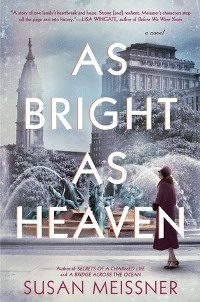 Writing with tremendous empathy, Meissner shows how a family is transformed by tragedy and hope during the 1918 influenza pandemic.
Writing with tremendous empathy, Meissner shows how a family is transformed by tragedy and hope during the 1918 influenza pandemic.Pauline Bright has finally made her peace with death after the passing of her infant son, Henry. When her husband Thomas agrees to take over his elderly Uncle Fred’s mortuary business in Philadelphia, he sees it as an opportunity to improve their circumstances. For Pauline, though, their big-city move and new profession are a natural progression for her ongoing grief.
She and her three daughters narrate in turns, in styles fitting their ages and personalities. Evie, fifteen, loves books and learning and develops a fond attachment to a fellow student. Twelve-year-old Maggie, full of curiosity and youthful eagerness, has a huge crush on an older male neighbor who’s about to leave for war. The chapters from six-year-old Willa are realistic in their innocence and brevity. Kept away from the dangerous chemicals in the “Elm Bonning Room,” Willa makes friends at school, but peer pressure makes her avoid a German-American classmate without knowing exactly why.
Meissner shows the impact of larger events via more intimate moments. In September, the Brights attend the Liberty Loan Parade, a massive public event that serves to spread influenza. Soon, the disease lands on their literal doorstep, changing their respectable home and business into a processing site for the newly dead. At this height of emotional turmoil and sorrow, one split-second decision—the rescue of an orphaned boy—gives them the strength to carry on but has repercussions.
This affecting portrait of our grandparents’ and great-grandparents’ time feels authentic, from Philadelphia’s extensive streetcar system to the brazen sounds of Prohibition-era speakeasies. Its touching story of mortality, love, and grace will also have readers pondering the many forgotten lives that the Spanish Flu snuffed out too soon.
As Bright as Heaven is published today in hardcover & ebook by Berkley; I wrote this review for February's Historical Novels Review. This year marks a century since the influenza epidemic of 1918-19. Reading this novel gave me a sense of what it was like to live through those traumatic circumstances.
Published on February 06, 2018 04:00



